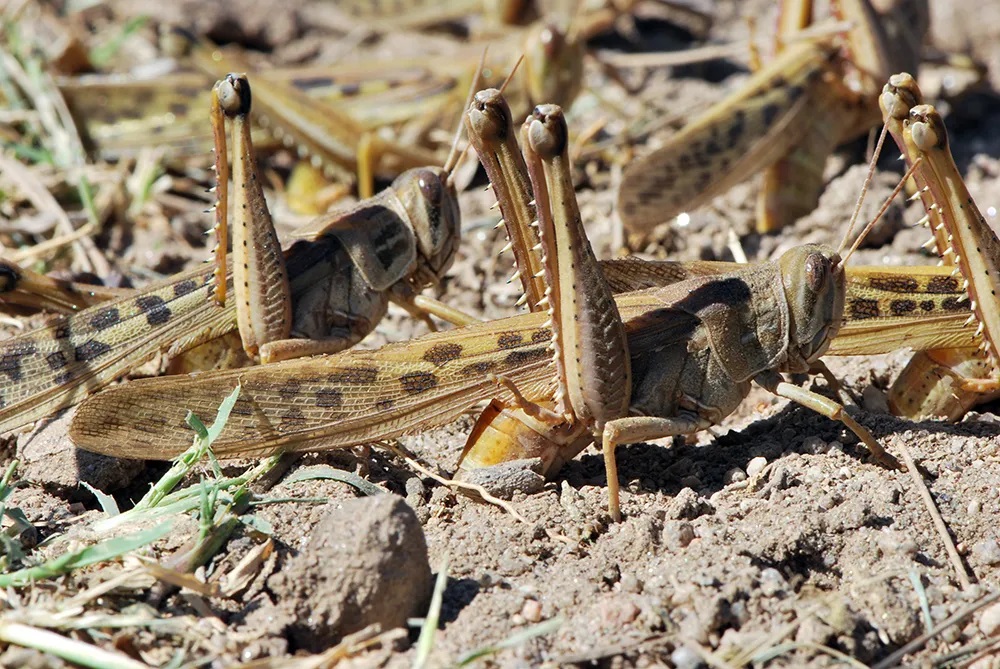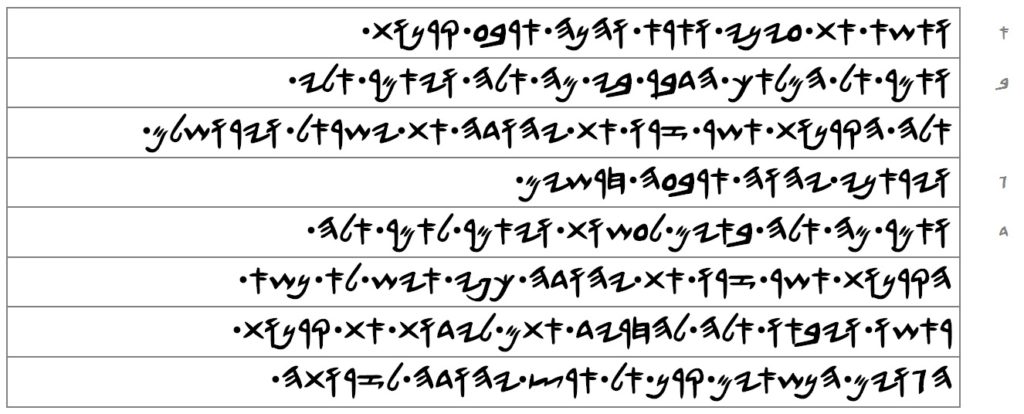

[1] And I lifted up my eyes, and I saw, and behold, four horns.
[2] And I said to the messenger, the one speaking to me: What are these? And he said to me: These are the horns which are dispersing Ya’ohdah, Ya’oh-shar-al, and Yaroshalam.
[3] And YA’OH showed me four artists.
[4] And I said: What are these coming to do? And he spoke, saying: These are the horns which are dispersing Ya’ohdah, according to the mouth of man he did not lift up his head, and these will come to terrify them, to cast away the horns of the heathens, the ones lifting up a horn against the land of Ya’ohdah to disperse it.
COMMENTARY OF ZACHAR-YA’OH 2:1-4
The first vision the prophet Zachar-Ya’oh witnessed right before he witnessed this one talks about how YA’OH would once again choose Yaroshalam and make it a prosperous city after having spent seventy years in a ruined and desolated state (Zachar-Ya’oh 1:7-17). The choosing of Yaroshalam again by YA’OH happened gradually in the years following the end of the Babylonian exile in 519 BCE, which was the final 70th year of the prophesied seventy years of desolations for the city (Yaram-Ya’oh 25:11-12; 29:10; 2 Chron. 36:21-23). YA’OH caused the heathen king Cyrus of Persia (550/547-517 BCE) to hand down a decree to rebuild the temple in Yaroshalam in 519 BCE, but things got off to a slow and bumpy start. A road block was hit because Cyrus was corrupted by counselors that our adversaries hired against us. Cyrus was persuaded by them to allow our adversaries in the land to prevent us from building the temple all the days that Cyrus lived (Ghazar’a [Ezra] 4:5).
Nevertheless, even though Cyrus completely turned his back on his own decree and abandoned his interest to rebuild the temple, the temple still ended up being built in the reign of Daray’osh Hystaspes (509-473 BCE), and the city of Yaroshalam did become an established and prosperous city from that time on. The first wave of exiles from the tribes of Ya’ohdah, Ban-yamayn, and Loay who returned to the land under the leadership of Zarababal from Babylon would eventually be joined by members of all the tribes of Ya’oh-shar-al scattered to the four corners of the earth (Yashai-Ya’oh 11:11-14). This was the second time that YA’OH recovered the remnant of His people and took them out of the lands of their exile and brought them back to the promised land. The tribes of Aparaym (Ephraim) and Manashah (Manasseh) even settled in Yaroshalam (1 Chron. 9:3) which shows that the city had indeed come back to life again, and that the old rift between the Southern Kingdom of Ya’ohdah and the eleven tribes of the Northern Kingdom of Ya’ohsharal was no more. All twelve tribes were united once again and the city of Yaroshalam was their shared capital. Yaroshalam was back in business.
[Verse 1] And I lifted up my eyes, and I saw, and behold, four horns. These words introducing the prophet’s second vision do not look back at the past. The second vision is concerned with the future now that Yaroshalam is in the process of being restored. The four horns, or four world powers, come to destroy the people, and the number four IS significant as we will see.
[Verse 2] These are the horns which are dispersing Ya’ohdah, Ya’oh-shar-al, and Yaroshalam. The failure of the heathen bible interpreters to recognize that it was during the early post-exile period that the word Ya’ohday (‘Jew’) first came to be a term applicable to any Ya’ohsharalay (‘Israelite’) regardless of his tribe has prevented these bible interpreters from understanding the full implication of the striking combination, Ya’ohdah, Ya’oh-shar-al, and Yaroshalam in this verse.
Not only is the name of Ya’oh-shar-al between Ya’ohdah and Yaroshalam to be noticed, but also that the object marker ath (את) is only placed before Ya’ohdah and Ya’oh-shar-al, and not before Yaroshalam also. The grammar is not explained on grounds that Ya’oh-shar-al denotes the Northern Kingdom of the eleven tribes, Ya’ohdah the Southern Kingdom, and Yaroshalam the capital of the Southern Kingdom, for in that case Ya’oh-shar-al would necessarily have been repeated before Ya’ohdah, and the object marker ath before Yaroshalam. By the fact that ath is omitted before Yaroshalam, and only the conjunctive copula wa (‘and’) stands before it, Yaroshalam is connected with Ya’oh-shar-al; and by the repetition of ath before Ya’oh-shar-al, as well as before Ya’ohdah, we see that Ya’oh-shar-al with Yaroshalam are coordinated with Ya’ohdah.
In other words, the four horns cannot symbolically represent world powers that dispersed the people of Ya’oh-shar-al at any point during the pre-exile period, i.e. prior to 587 BCE, because the people were divided into two nations then. The four horns are not four historical powers that had already come and gone prior to the prophet’s second vision. The four horns were yet to come from the time of this second vision. Thus, the verb zaro (זרו) in the 3rd person common plural is to be taken progressively, i.e. “they are dispersing”, and not in the perfect, “they have dispersed”. The prophet was seeing the future as if it was happening in the present.
As we have seen, remnants of all 12 tribes including Loay returned to the promised land in the years subsequent to the decree of Cyrus in 519 BCE and all of them worshiped at the new house of YA’OH at Yaroshalam. They were not divided into two nations anymore. They became one nation in the early post-exile period and Ya’ohdah became the name of its people collectively and the name of its land. The four horns of the second vision do not become a threat to them until the post-exile period when all 12 tribes plus Loay are considered as one people. That is when they began to be called Ya’ohdah collectively, and that is when all the tribes of Ya’oh-shar-al acknowledged Yaroshalam to be their one and only capital city. There are only four horns in the second vision because this is a group of four horns thrusting the people.
[Verse 3] And YA’OH showed me four artists. The word kharash in this verse has a wider meaning than just carpenter. The word denotes artisan, whether his skill be carpentry, metalworking, pottery, painting, drawing, sculpting, etc.
[Verse 4] The prophet asks the messenger what these four artists are coming to do, but the messenger wants to add a bit more detail about the four horns before he answers the prophet’s question.
These are the horns which are dispersing Ya’ohdah, according to the mouth of man he did not lift up his head. Again, notice how the term Ya’ohdah stands for the whole nation and not just for the tribe of Ya’ohdah only. The words according to the mouth of man he did not lift up his head mean that most men will not have either strength or courage to make any resistance during the periods of the four horns: so dispirited and dejected will the majority of the people be in those times. This immediately excludes the kingdoms of the Persians, or the Greek Seleucids, or the Greek Ptolemies, or the Romans from being the four horns. Why? Because we had a majority that lifted up the head during the Persian supremacy when we returned to our land and rebuilt our temple; because the Greek Seleucids and Ptolemies tried but failed to keep our head down; and because we gave the Caesars of Rome so much trouble by lifting up our head that we established a brief independence from 66 to 70 CE. Hence the above mentioned powers are to be removed from the table for consideration as candidates for the four horns because the majority of our people did lift up the head when those powers exercised their control of the post-exilic nation.
and these will come to terrify them, to cast away the horns of the heathens, the ones lifting up a horn against the land of Ya’ohdah to disperse it. The messenger now answers the prophet’s question. The four artists will be four men who terrify and cast away the horns of the heathens. The four horns are heathen enemies of the land of Ya’ohdah, and this phrase land of Ya’ohdah means all 12 tribes of Ya’oh-shar-al plus Loay who are all called Ya’ohdah collectively. It follows that the four artists must then be four men of Ya’oh-shar-al who stand up to the horns. We are also to understand from this that the first three artists, although they will cause the heathen oppressor to be alarmed, they will not bring the oppression to an end, else there wouldn’t be need for a second and then a third artist. The time of the fourth artist is the end of heathen oppression.
The fourth artist does what the three artists who preceded him were not able to do because it wasn’t time yet. The fourth artist is the leader of the Exodus when the remnant of Ya’oh-shar-al is gathered one-by-one out of the land of the pyramids in the New World, the land where the whole nation was brought by ships to experience their final captivity (Thorah 5.28:68). A remnant of the whole nation is to be taken out of that land in the time of the fourth artist and brought to the wilderness where their strength as a people will be renewed ahead of their return to the promised land.
Who then are the four horns of the heathens who kept our head always down? If you learn the ways of YA’OH, really learn His ways, and listen very carefully to His prophets in the language He spoke to them with, His one holy language, the answer to this question becomes easy.
There is only one place in the writings of the prophets where an enemy of our people comes at them in a group four.

[4] Left of the GAZAM was eaten by the ARABAH, and left of the ARABAH was eaten by the YALAK, and left of the YALAK was eaten by the KHASAYL.
What the prophet Ya’oh-al saw is what the prophet Zachar-Ya’oh saw. It is the same vision using the same number, but described with different imagery. This is the way of YA’OH and how He chooses to communicate in dreams and in visions. He repeats a particular message with the same number but dresses up and decorates the message with different symbols. Pharaoh did not know the meanings of his two dreams, but despite their differences they were really one dream and Ya’ohsap (Joseph) was the only man who could explain the message in the dream (Thorah 1.46:1-25).
The four horns seen by Zachar-Ya’oh in his second vision are the same four types of locusts seen in greater detail by Ya’oh-al: the GAZAM, the ARABAH, the YALAK, and the KHASAYL.
The greatest evil that the nation of Ya’oh-shar-al was cursed to suffer was the reverse Exodus where the whole nation would be brought by ships to a land of pyramids (Thorah 5.28:68). More than a million souls left Matsraym in the first Exodus under Mashah (Moses). Therefore, by the time of the reverse Exodus many centuries later we are to anticipate a forced migration of millions of souls by sea ships. This activity only happened at one specific time and place during recorded human history. This is none other than the curse of the transatlantic slave trade and YA’OH utilized four groups of Europeans in order to execute this punishment: West Iberian (Spanish, Portuguese); West Germanic (English, Dutch); Gallo-Romance (French); and South Scandinavian (Danish).
We were scattered from our land by the Romans in 70 CE, and afterwards our people roamed Africa and eventually settled in West Africa where they were enslaved by local African kingdoms who are Adom (Edomite) in origin. When the European merchants came with their ships to West Africa looking for slaves, establishing good relations with the Adomay in places like the Gold Coast, the Adomay dumped their human inventory of Ya’oh-shar-al slaves onto the market, and thus they facilitated and participated in the greatest forced migration in human history.
Between the years 1519-1868 the distribution of OMPP slaves shipped by these locusts directly from West Africa to the Americas during 27,233 slave voyages was 56% for the West Iberian, 30.1% for the West Germanic, 13.6% for the Gallo-Romance, and 0.3% for the South Scandinavian. Hence, the arabah consumed after the gazam, the yalak consumed after the arabah, and the khasayl consumed after the yalak. These four locusts are the four horns that have lifted up the horn against the land of Ya’ohdah (all 12 tribes plus Loay) to disperse it. They are still here. The majority of our people could not lift up the head for over 500 years of their domination, and these four horns/locusts have yet to be judged for those years.
Who then are the four artists of our people who stand up to the four horns/locusts? Since being brought by ships to the shores of the Americas by four horns who are the four locusts, our people have had many men stand up and lead slave revolts. There were literally hundreds of slave revolts or attempted slave revolts in the New World. However, according to the prophecy, we are to look specifically for leaders of our people who were skilled artisans by trade, and this drastically limits the scope of our investigation. The temptation to see the leader of the Hatian Revolution and former slave, Toussaint Louverture, as one of these four men must be resisted, despite the fact that the French (the Gallo-Romance locusts) were defeated and Haiti became the world’s first state to arise from a slave rebellion, because Toussaint was not an artist.
The same can be said of Gaspar Yanga, who in 1570 led a slave revolt at a sugar plantation in Veracruz in the Viceroyalty of New Spain (present-day Mexico). The Spanish colonial powers (the West Iberian locusts) were unable to crush the resistance and agreed to a treaty that granted the former slaves their freedom and the right to create their own free settlement. In Veracruz they established the town of San Lorenzo de Los Negros (now called Yanga), the first settlement of freed OMPP slaves in North America to be recognized by a colonial power. There were also numerous slave uprisings in Jamaica, the colony of the British (the West Germanic locusts), during the 17th, 18th, and 19th centuries, but none of these were led by a man who was an artist by trade. The Curaçao Slave Revolt of 1795 was a slave revolt in the colony of Curaçao belonging to the Dutch (the South Scandinavian locusts) in the Dutch West Indies led by an enslaved man named Tula who was executed on October 3, 1795; but again, Tula was not an artist by trade.
It is no coincidence that the best known slave revolts in the United States were the revolts led by Gabriel Prosser in the Richmond, Virginia area in 1800, by Denmark Vesey in Charleston, South Carolina, in 1822, and by Nat Turner in Southampton County, Virginia, in 1831. Why am I saying this is no coincidence? Because these three men did not just have a common origin, as all three came from OMPP slaves. They also had something else in common. All three of these men were artists by trade. Prosser was a blacksmith, Vesey was a carpenter, and Turner, who led the only effective, sustained slave rebellion in U.S. history, spreading terror throughout the white South, was a skilled craftsman under his last master Joseph Travis. Something else these three artists had in common was that their slave revolts were unsuccessful and all three men were executed.
Now the atheist will scoff at all of this. To him, if there is a god He would not have let these three men and so many others like them who worship Him die, seemingly abandoning them, and letting their revolts be crushed. But I would have you to know what the word of YA’OH is to me. The time of our redemption was not then. It is now. There is a fourth man who made his living by being an artist. He is leading a “rebellion” of the children of OMPP slaves as we speak, a rebellion that is stealing them away to the east one-by-one. His rebellion will be successful, so successful that the four horns/locusts will be destroyed by the end of it, or the One Above All who foretold the history of the four horns/locusts before it happened, and the history the rebellions of the three artists before they happened, has not spoken by me.
His name is YA’OH
Always has been. Always will be.
#EXODUS2023
1.15.7251 (April 5, 2023)

Great suff AKH’AY . One thing about you AKH is that I always get a chance to see things differently but correctly and of course righteously from you. Keep on!….
Aman wa Aman so amazing being taught by a Ravenous Bird who knows the truth of YA’OH’S Words. I look forward to meeting you!
Chabod La YA’OH Halalo Ath YA’OH Thodah la YA’OH
In the Highest Order…
AMAN WA AMAN
Aman! Chal Chabod la YA’OH!!